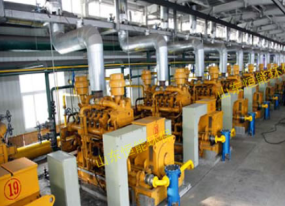欢迎进入山东恒能环保能源设备有限公司
欢迎进入山东恒能环保能源设备有限公司
沼气提纯技术主要包括吸收法、变压吸附法、低温冷凝法和膜分离法四种方法,每种方法均基于不同的物理或化学原理实现二氧化碳与甲烷的高效分离。
Biogas purification technology mainly includes four methods: absorption, pressure swing adsorption, low-temperature condensation, and membrane separation. Each method is based on different physical or chemical principles to achieve efficient separation of carbon dioxide and methane.
吸收法利用有机胺溶液(如一级胺、二级胺、三级胺及空间位阻胺等)对二氧化碳的物理和化学吸收特性,在吸收塔内通过常温加压条件促使胺液与沼气中的二氧化碳发生可逆反应,从而实现碳捕集。随后,富集二氧化碳的吸收液被输送至再生塔,在加热减压条件下发生解吸反应,释放出高纯度二氧化碳气体,同时再生后的贫液重新具备吸收能力并返回系统循环使用。该工艺通过连续的吸收-再生循环实现沼气的持续脱碳净化,具有较高的甲烷回收率,但能耗相对较高。
The absorption method utilizes the physical and chemical absorption characteristics of organic amine solutions (such as primary amines, secondary amines, tertiary amines, and steric hindrance amines) for carbon dioxide. In the absorption tower, reversible reactions between amine solutions and carbon dioxide in biogas are promoted under normal temperature and pressure conditions, thereby achieving carbon capture. Subsequently, the carbon dioxide enriched absorption solution is transported to the regeneration tower and undergoes desorption reaction under heating and pressure reduction conditions, releasing high-purity carbon dioxide gas. At the same time, the regenerated lean solution regains its absorption capacity and is returned to the system for recycling. This process achieves continuous decarbonization and purification of biogas through a continuous absorption regeneration cycle, with a high methane recovery rate but relatively high energy consumption.
变压吸附法(PSA)则依托吸附剂(如分子筛、活性炭等)对二氧化碳的选择性吸附能力,通过周期性压力变化实现气体分离。在高压吸附阶段,原料气中的二氧化碳被吸附剂截留,而甲烷等弱吸附组分作为净化气输出;当吸附剂趋于饱和时,系统通过降压或抽真空方式促使二氧化碳脱附再生。为确保连续运行,PSA装置通常配置两个以上的吸附塔交替作业,通过多塔协同实现不间断处理。该技术流程简洁且适应性强,但对吸附剂性能及控制系统要求较高。
Pressure swing adsorption (PSA) relies on the selective adsorption ability of adsorbents (such as molecular sieves, activated carbon, etc.) for carbon dioxide, and achieves gas separation through periodic pressure changes. In the high-pressure adsorption stage, carbon dioxide in the feed gas is intercepted by the adsorbent, while weakly adsorbed components such as methane are output as purified gas; When the adsorbent approaches saturation, the system promotes the desorption and regeneration of carbon dioxide through pressure reduction or vacuum pumping. To ensure continuous operation, PSA units are usually equipped with two or more adsorption towers operating alternately, achieving uninterrupted processing through multi tower collaboration. This technology has a simple process and strong adaptability, but requires high performance of the adsorbent and control system.

低温冷凝法基于二氧化碳与甲烷沸点的显著差异,通过深度冷却使二氧化碳液化析出,甲烷则作为不凝气获得提纯。为提升能效,该工艺常采用余冷回收技术降低能耗,但其设备投资大、操作条件苛刻,尤其适用于高浓度二氧化碳沼气体系。膜分离技术则利用不同气体组分在膜材料中的渗透速率差异实现分离:二氧化碳因渗透性快于甲烷而优先透过膜层,甲烷则作为滞留气得到富集。工业上通常采用多级膜组串联工艺以提高甲烷纯度,该技术具有模块化、易扩容的优点,但膜材料成本及抗污染能力仍是制约因素。
The low-temperature condensation method is based on the significant difference in boiling points between carbon dioxide and methane. Through deep cooling, carbon dioxide is liquefied and precipitated, while methane is purified as a non condensable gas. To improve energy efficiency, this process often uses residual cooling recovery technology to reduce energy consumption, but its equipment investment is large and the operating conditions are harsh, especially suitable for high concentration carbon dioxide biogas systems. Membrane separation technology utilizes the difference in permeation rates of different gas components in membrane materials to achieve separation: carbon dioxide preferentially penetrates the membrane layer due to its faster permeability than methane, while methane is enriched as a retained gas. In industry, multi-stage membrane cascade process is commonly used to improve methane purity. This technology has the advantages of modularity and easy scalability, but the cost of membrane materials and anti pollution ability are still limiting factors.
从工程应用现状来看,吸收法与变压吸附法因技术成熟度高、经济性较好而占据主流,尤其适用于大中型沼气提纯项目;而低温冷凝法与膜分离法则受限于技术复杂度或运行成本,目前应用范围相对有限。未来随着材料科学及工艺优化的进步,这些技术有望在特定场景中展现更大潜力。
From the current status of engineering applications, absorption method and pressure swing adsorption method dominate due to their high technological maturity and good economic efficiency, especially suitable for large and medium-sized biogas purification projects; However, the low-temperature condensation method and membrane separation method are limited by technical complexity or operating costs, and their current application scope is relatively limited. In the future, with the advancement of materials science and process optimization, these technologies are expected to demonstrate greater potential in specific scenarios.
本文由沼气脱硫友情奉献.更多有关的知识请点击:https://www.hneee.net我们将会对您提出的疑问进行详细的解答,欢迎您登录网站留言.
This article is a friendly contribution from biogas purification For more information, please click: https://www.hneee.net We will provide detailed answers to your questions. You are welcome to log in to our website and leave a message